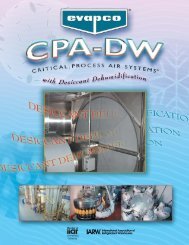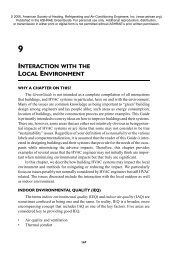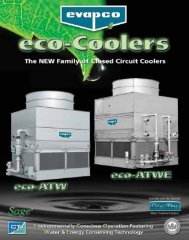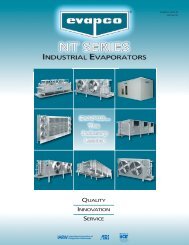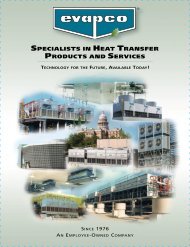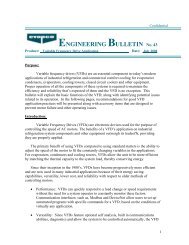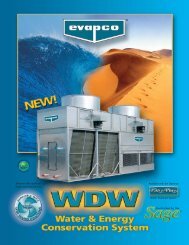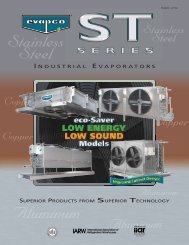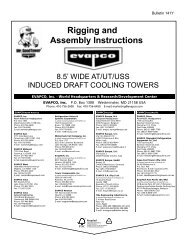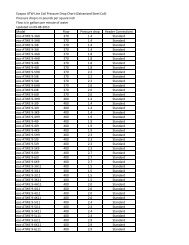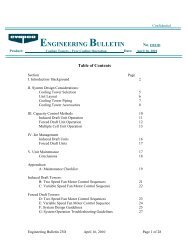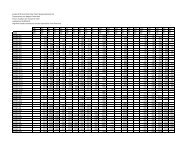The Use of Variable Frequency Drives Engineering Bulletin
The Use of Variable Frequency Drives Engineering Bulletin
The Use of Variable Frequency Drives Engineering Bulletin
Create successful ePaper yourself
Turn your PDF publications into a flip-book with our unique Google optimized e-Paper software.
<strong>The</strong> cost and functionality <strong>of</strong> state-<strong>of</strong>-the-art PWM variable frequency drives makes them a<br />
very attractive control option for owners and operators <strong>of</strong> cooling towers to save energy and<br />
reduce noise in non-peak periods. <strong>The</strong> use <strong>of</strong> VFD technology can also benefit the life <strong>of</strong> the<br />
mechanical components with fewer starts, smoother starts, and built-in motor diagnostics.<br />
VFD technology has particular benefit on towers operating in cold climates where airflow can<br />
be modulated to minimize icing and reversed at low speed for de-icing cycles.<br />
Cooling Tower Applications<br />
As with any technology, improper customer expectations, poor specifications and bad<br />
installation practices lead to problem VFD applications. Successful VFD installations cannot<br />
be made casually, all applicable VFD drive, motor and tower manufacturer recommendations,<br />
in addition to local electrical codes and best electrical grounding and conduit practices must be<br />
strictly followed.<br />
Motor Concerns<br />
On August 1, 2000, EVAPCO announced that all equipment whose motors will be driven by<br />
VFD’s must be provided with inverter-duty motors in order to maintain the motor warranty.<br />
Motors utilized in VFD applications are not covered under warranty by either the motor<br />
manufacturer or EVAPCO unless inverter-duty motors are supplied.<br />
<strong>The</strong> power supplied to the motor by a VFD is not smooth. <strong>The</strong> inverter within the VFD takes<br />
the 60 hz power then chops and re-shapes the AC sine wave. This simulated AC voltage<br />
contains spikes and irregularities that must be absorbed by the motor windings. VFD duty<br />
motors are built with heavy-duty windings and are equipped with extra heat dissipation<br />
features to handle the VFD application. In addition, spike resistant wire is utilized in our VFD<br />
duty motor design.<br />
<strong>The</strong> type <strong>of</strong> motor, manufacturer <strong>of</strong> VFD, motor lead lengths (between the motor and VFD),<br />
conduit runs and grounding can dramatically affect the response and life <strong>of</strong> the motor.<br />
<strong>The</strong> motor lead length restriction varies with the motor vendor. <strong>The</strong> US Motors Inverter Duty<br />
motor design has no restrictions on motor lead length. However, Baldor, another supplier <strong>of</strong><br />
motors for EVAPCO puts restrictions on the distance from the inverter to the motor based on<br />
voltage:<br />
460 Volt-100 feet or less<br />
575 Volt-50 feet or less<br />
Regardless <strong>of</strong> motor supplier, minimizing motor lead length between the motor and inverter is<br />
good engineering practice.<br />
Although EVAPCO VFD (Inverter-Duty) motors have a 5 year standard warranty, this does<br />
not mitigate the reality that running a motor on a VFD will reduce bearing life. Motors<br />
operated in VFD service are more susceptible to bearing failure due to the high frequency<br />
switching and transient voltage spikes formed between the rotor and stator. An option is<br />
available (albeit an expensive one) for insulated bearings to protect the bearing from these<br />
shaft currents.<br />
2



